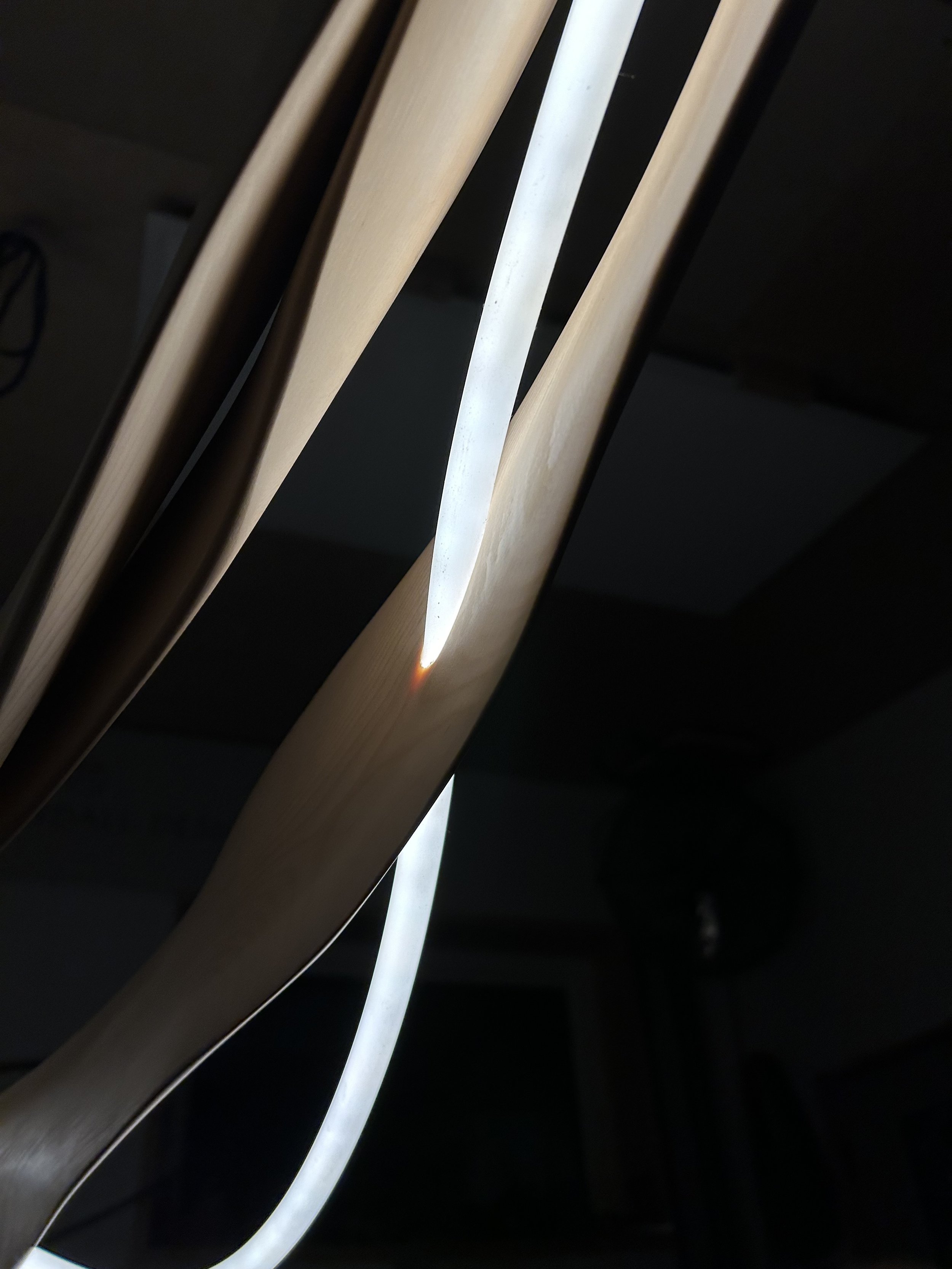Inspiration From Our Coast
In recent years, I’ve been commissioned to create two large-scale Kelp installations—kinetic sculptures designed to move and sway with the passing breeze, capturing the gentle rhythm of underwater forests.
The first, crafted from a combination of steam-bent western maple and ash, is suspended in the lobby of Brentwood Bay Resort & Spa. Commissioned by Bidgood Interior Design Studio, this piece is publicly accessible during the resort’s opening hours. The second, a private commission for a home in Comox, was hand-carved from steam-bent yellow cedar. This installation features a luminous ribbon of light weaving through the organic forms like the tendrils of a sea jelly, enhancing its ethereal quality.
Both sculptures were inspired by my time spent working on the waters of the Salish Sea and exploring its tide pools with my family, translating the fluidity and grace of the sea into tangible, dynamic forms.
Define “Observatory”
I grew up in Gonzales, and have a strong emotional connection to the Observatory, which for my whole life has felt like a sentinel watching over my neighborhood and home.
Designed collaboratively by architect William Henderson and meteorologist Francis Napier Denison as a home and observatory, it was built to further exploration of celestial realms.
Now, drowned in city lights, its purpose has faded. The exterior remains popular – a dramatic silhouette against the sky, a sought-after photography spot—but almost no one can step inside. Within, the original wooden dome still arches overhead, above empty rooms once designed to house an Observer, according to the original plans.
In my architectural thesis, I proposed repurposing it for an Artist in Residence program, welcoming cultural Observers to live and create within its walls. With renovation, it could become a space where artists turn their gaze inward and share those observations in exhibitions open to the public. Fitting its iconic appearance, the observatory could once again become a place of discovery— with a new, human-centered focus.
Dive Right In
Before the Banfield Dock expansion, there was another small but impactful dock design in the Gorge waterway.
Project Albero, a floating circular dock, emerged from a collaboration between local companies Aryze, DAU and Biophilia. Inspired by the successes of other harbor cities, where residents flock to the water on hot summer days, the team reflected, “It struck us that in Victoria, we have all the bones for this lifestyle, but our public realm is disconnected from its potential for harbor recreation.”
With the introduction of the Banfield Dock expansion just four years later, its clear that this small intervention has done exactly what it set out to do and convinced many Victorians to connect with the water and go for a dip!
The Sunset Mug
Inspired by the landscape while taking her dogs on their daily walk through Playfair Park, local ceramicist Michele Agostinelli snaps an image of the sunset.
Drawing inspiration from the colours and forms made by the clouds, she creates a set of mugs and tumblers with pink, orange, and yellow hues.
"I find inspiration from the landscape for most of my projects. Rocky beaches interacting with dense, green forests, or the seaweed clustered together between barnacle covered rocks. I've even made clay barnacles and added them to a sides of plates I did for a dockside restaurant - the dishwashers didn't like me very much... But it helped cultivate a sense of place through the dining experience!"
Her work is an echo of the place she calls home.
The Blue Bridge
Newcomers to Victoria might be puzzled to find the Johnson Street bridge is often referred to as the “Blue Bridge”… despite it not being blue.
The name comes from the bridge’s former incarnation, which was painted the colour to cover up corrosion repairs done in the late 70’s.
While the current bridge has lost it’s iconic colour, at night, you might notice the LED lighting paying homage to the bridge that came before.
Painted Poles
The story of Fernwood’s iconic telephone poles is a story about the tension between safety and placemaking.
The tradition began in 2008, with a local artist and activist, Beth Threfall. Inspired by the ‘intersection repair’ movement, which used pubic are to foster community and a sense of place, she started painting the poles in Fernwood. The small project grew into the annual Pole Painting Day, with free paint salvaged from the Hartland Landfill.
After 11 years, BC Hydro issued a province-wide ban on painted telephone poles, citing safety concerns - painted poles were more prone to rot and made it harder for workers to assess damage.
The Secret Ban
Did you know that skateboarding downtown in Victoria was illegal for almost 15 years? In the early ‘90s fueled by complaints that skateboarding was a ‘serious social problem,’ the city outlawed skateboarding in the downtown core with bylaw officers able issue fines and confiscate boards.
Despite the ban being lifted in 2016, skateboarding is still heavily discouraged, taking the form of metal strips bolted onto seemingly every bench, ledge, and railing downtown.
These deterrence pieces are so ubiquitous in urban design that they are often installed before a single skateboarder has been there. The Courthouse playground, opened in 2017, had anti-skateboarding strips installed before the public had ever set foot inside.








